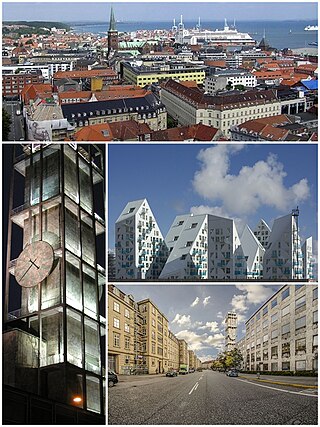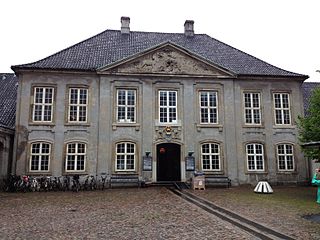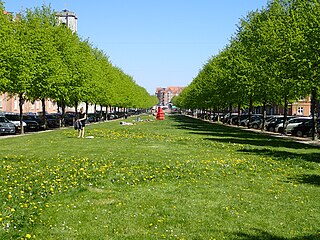
Aarhus is the second-largest city in Denmark and the seat of Aarhus Municipality. It is located on the eastern shore of Jutland in the Kattegat sea and approximately 187 kilometres (116 mi) northwest of Copenhagen.

Hinnerup, is a small town in East Jutland, Denmark with a population of 8,351, located in Favrskov Municipality, Region Midtjylland, Jutland just northwest of Aarhus. It is more or less a suburb nowadays, connected to Aarhus by the urban tract of Søften, Lisbjerg and Skejby.

Copenhagen Business School often abbreviated and referred to as CBS, is a public university situated in Copenhagen, Denmark and is considered one of the most prestigious business schools in Western Europe and the world.

Aarhus Airport is a civilian airport located 19.4 nautical miles northeast of Aarhus, Denmark.

The Designmuseum Denmark is a museum in Copenhagen for Danish and international design and crafts. It features works of famous Danish designers like Arne Jacobsen, Jacob Jensen and Kaare Klint, who was one of the two architects who remodeled the former Frederiks Hospital into a museum in the 1920s. The exhibition also features a variety of Chinese and German porcelain.

Marselisborg Palace is a royal residence of the Danish royal family in Aarhus. It has been the summer residence of Queen Margrethe II since 1967.

Cobe is a Copenhagen-based architectural firm owned and managed by architect Dan Stubbergaard. As of 2020, the office has 150 employees and is involved in a large number of projects throughout Europe and North America within urban planning, architecture, landscape architecture and interior design.

Schmidt Hammer Lassen (SHL) is an international architectural firm founded by a group of Danish architects in 1986 in Aarhus, Denmark. It currently has three offices in Copenhagen and Aarhus in Denmark, as well as Shanghai, China. In 2018, Schmidt Hammer Lassen became part of global architecture and design firm Perkins and Will.

The architecture of Denmark has its origins in the Viking Age, richly revealed by archaeological finds. It became firmly established in the Middle Ages when first Romanesque, then Gothic churches and cathedrals sprang up throughout the country. It was during this period that, in a country with little access to stone, brick became the construction material of choice, not just for churches but also for fortifications and castles.

Arkitema Architects is a Danish architectural firm headquartered in Aarhus, with branch offices in Copenhagen, Malmö, Stockholm and Oslo. Arkitema Architects was founded in 1969 in Aarhus, and nowadays has about 400 employees with its main activity in Scandinavia.
Realdania is a private association in Denmark which supports projects in architecture and planning. It was established in 2000 following the sale of Realkredit Danmark to Danske Bank, when a fund of approximately 20 billion kroner was put aside for "philanthropic" purposes. Realkredit Danmark was owned and controlled by its members, and this set-up was kept in Realdania.
The following is a timeline of the history of the city of Aarhus, a city in central Denmark.
Kristine Jensen, is a Danish architect who has specialized in landscape architecture.

The State and University Library in Aarhus, Denmark, is a national library and the university library of Aarhus University. It is a research library and the central repository for all Danish public libraries holding millions of items both in print and digital formats including sound and music recordings, videos, journals, books, patents, maps, prints and drawings. The library is directly subordinated the Danish Ministry of Culture and is a legal deposit library, receiving copies of all audio, video and newspapers produced in Denmark.

The architecture of Aarhus comprises numerous architectural styles and works from the Middle Ages to present-day. Aarhus has a well-preserved medieval city center with the oldest dwellings dating back to the mid-1500s and some ecclesiastical structures such as St. Clemen's Cathedral and numerous smaller churches that can be traced back to the 1100s. The industrialization of the 19th and 20th centuries left distinctive industrial structures, important National romantic works and some of the best examples of Functionalist architecture in the country. The history of the city as a Viking fort is evidenced in the street layout of the Latin Quarter, the wider Indre By neighborhood testifies to its later role as a Market town and center of commerce while the Frederiksbjerg, Trøjborg and Marselisborg districts showcase the first cohesive urban planning efforts of the early 20th century.

Ofelia Plads is a public space situated on the Kvæsthus Pier next to the Royal Danish Playhouse on the harbourfront in Copenhagen, Denmark. It is owned by the Ministry of Culture and Jeudan and is used as an open-air venue by the Royal Danish Theatre. It was completed in 2016 to design by Lundgaard & Tranberg and is located on top of an underground parking facility with room for 500 cars.

Christians Brygge is a waterfront and street in central Copenhagen, Denmark. It runs from the mouth of Slotsholmen Canal in the north to Langebro Bridge in the south where it turns into Kalvebod Brygge. Its northern end, which is located on the small isle of Slotsholmen, is connected to Niels Juels Gade and then Holmens Kanal by Christian IV's Bridge. Christians Brygge The road section is part of Ring 2. The name refers to Christian IV, king of Denmark during the first half of the 17th century, who constructed several buildings at the site, including the Arsenal and Christian IV's Brewhouse as well as nearby Børsen. Other landmarks along the quay include the Royal Danish Library and the mixed-use building BLOX, home to the Danish Architecture Centre.

Ingerslevs Boulevard is a street in Aarhus, Denmark. It is 500 meters long and runs west to east from Harald Jensen's Plads to Skt. Anna Gade. The street is situated in the Frederiksbjerg neighborhood where it is functionally the main street but parts of it also acts as a public green space owing to width and central lawn. Ingerslevs Boulevard is home to St. Luke's Church and two schools, N.J. Fjordgade's School and Frederiksbjerg School. It is a mostly residential area but the street itself hosts a farmer's markets twice a week. Ingerslevs Boulevard was developed in the early 20th century as a main component of Frederiksbjerg when the neighborhood was created based on a unified urban planning design.
Praksis Arkitekter is a Danish architectural firm with offices in Troense, Svendborg. It was founded and is owned by Mette Tony and Mads Bjørn Hansen. The firm received Dreyers Fond's Honorary Award for Architecture in 2017.






























